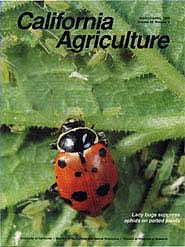


University of California
California Agriculture
|
|||
|
|||

Lady bugs suppress aphids on potted plants
Cover:
Lady beetle preys on aphids on potted plants. Photo by Jack Kelly Clark
March-April 1995
Volume 49, Number 2 |
|||
|
University of California, 1301 S. 46th St., Bldg. 478 Richmond, CA
|